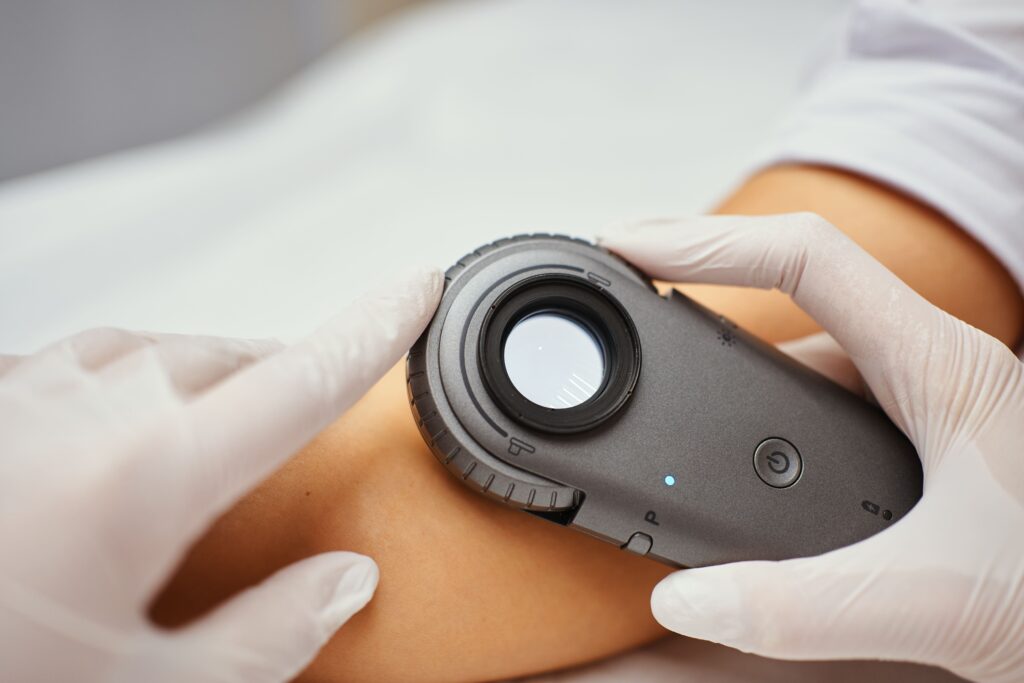Reviewed by: Joshua M. Newman, M.D.
Summertime is when many of us think about wearing sunscreen and protecting our skin. But protecting our skin is something we should think about all year. Some may not expect skin cancer to be ranked as the most common cancer type in the United States. However, if caught early, it is mostly preventable, and if caught early, it is usually curable with skin cancer treatment.
Three Types of Skin Cancer
UV rays from the sun or tanning beds damage skin cells and cause skin cancer. There are three types of skin cancer. They are basal cell carcinoma, squamous cell carcinoma, and melanoma.
Basal cell carcinoma is the most commonly diagnosed. It is the least dangerous form of skin cancer and doesn’t normally spread. It’s important to catch it early so that the surgical removal is as non-invasive as possible. It often appears on sun-exposed areas as small pink bumps. Some of the features basal cell carcinoma has are a pearly or waxy appearance, a sunken center, irregular blood vessels on the surface and a tendency to bleed easily after injury.
Squamous cell carcinoma is slightly more dangerous and can spread and if not recur if not caught early. Squamous cell carcinoma is usually found on sun-exposed areas such as the head, hands, ears, back of the neck, and forearms. It is often described as raised, dull-red skin lesions, thick-crusted and ulcerated.
Melanoma is very serious. It requires aggressive skin cancer treatment which may include chemotherapy or surgery. According to the American Cancer Society in 2021, most deaths caused by skin cancer are attributed to melanoma. To detect melanoma, be aware of any changes to your skin, such as new moles, lesions, or spots that don’t heal quickly.
If you notice a suspicious mole or spot, follow the ABCDEs of melanoma and look for these indicators:
A: Asymmetry – is the mole asymmetric
B: Borders – the mole has an irregular, scalloped or poorly defined border
C: Color – The mole has various colors throughout the mole such as shades of tan, brown, or black or areas of white, red, or blue.
D: Diameter – most melanomas are more than six millimeters or about the size of a pencil eraser however they can be smaller.
E: Evolving – The mole has changed in size, shape, or color
If you notice any of these changes in a mole or lesion, make an appointment with your physician to have it checked.
Skin Cancer Risk Factors
There are risk factors for getting skin cancer.
They include:
- having fair skin,
- having a family history of skin cancer,
- spending extended periods of time in the sun throughout your life
- many sunburns as a child or adolescent
- using tanning beds
- chronic, non-healing wounds
To minimize risks, it’s crucial to acknowledge these risk factors and take appropriate actions. The best way to prevent skin cancer is by avoiding UV exposure when possible. Wear sunscreen with an SPF of at least 30 when going outside, even on cloudy days or in wintertime. It is recommended to wear protective clothing such as shirts with long sleeves and hats with wide brims. When out during peak hours for UV rays (between 10 am and 4 pm), seek shade whenever possible. Do a thorough skin check regularly. It is recommended to do this once a month.
Importance of Early Detection
Early detection is key for successful skin cancer treatment. The chances of surviving skin cancer with early detection are nearly 100 percent. Regular skin checks are strongly recommended and can help catch any early signs of cancer before it spreads.
If you observe anything that seems abnormal or not typical, schedule an appointment with your doctor promptly. For more information on skin cancer testing or skin cancer diagnosis, contact Amara Aesthetic Surgery and Dermatology at (941) 499-7823.



